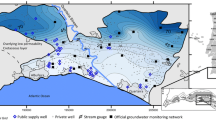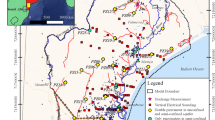Abstract
Submarine groundwater discharge (SGD) is approached differently by terrestrial hydrogeologists and marine scientists, including whether to incorporate recirculated seawater with freshwater in the definition. This paper focuses on the major hydrogeologic modeling/calculational methods, what component of SGD they quantify and on what scale. It then compares the modeling methods to direct measurement and geochemical techniques used by marine scientists. Hydrogeologic modeling methods focus primarily on freshwater, but recirculated seawater can be examined with density-dependent, solute transport numerical modeling. Direct physical measurements and geochemical tracers performed in the marine environment can quantify fresh, brackish, or seawater fluxes, so that they are not always comparable to the results of modeling. Because of differences in the geochemistry (nutrients and other dissolved species) of fresh and saline waters, for many applications it may be necessary to distinguish between the fresh and recirculated seawater components of SGD.
Similar content being viewed by others
References
Bokuniewicz HJ (1980) Groundwater seepage into Great South Bay, New York. Estuarine Coast. Marine Sci. 10: 437–444
Bradley DE &; McKee LJ (2002) Carbon, nitrogen, and phosphorus budgets for a shallow subtropical coastal embayment (Moreton Bay, Australia). Limnol. Oceanogr. 47: 1043–1055
Burnett W &; Turner J (2001) LOICZ group investigates groundwater discharge in Australia. LOICZ Newslett. 18: 1–4
Burnett W, Chanton J, Christoff J, Kontor E, Krupa S, Lambert M, Moore W, O'Rourke D, Paulsen R, Smith C, Smith L &; Taniguchi M (2002) Assessing methodologies for measuring groundwater discharge to the ocean. EOS, Trans. Am. Geophys. Union 83(11): 117 and 12–123
Carabin G &; Dassargues A (1999) Modeling groundwater with ocean and river interaction. Water Resour. Res. 35(8): 2347–2358
Garrison GH, Glenn CR &; McMurtry GM (2003) Measurement of submarine groundwater discharge in Kahana Bay, O'ahu, Hawaii. Limnol. Oceanogr. 48: 920–928
Gilbin AE &; Gaines AG (1990) Nitrogen inputs to a marine embayment: the importance of groundwater. Biogeochemistry 10: 309–328
Harvey JW &; Odum WE (1990) The influence of tidal marshes on upland groundwater discharge to estuaries. Biogeochemistry 10: 217–236
Johannes RE (1980) The ecological significance of the submarine discharge of groundwater. Marine Ecol. Progr. Ser. 3: 365–373
Johnson MJ (1988) Geohydrology and mathematical simulation of the Pajaro Valley aquifer system, Santa Cruz and Monterey counties, California. US Geological Survey, Waterresources Investigation Report 87-4281
Kanehiro BY &; Peterson FL (1977) Groundwater recharge and coastal discharge for the northwest coast of the island of Hawaii: a computerized water budget approach. Water Resources Research Center, University of Hawaii, Technical Report No. 110
Moore W (1996) Large groundwater inputs to coastal waters revealed by 226Ra enrichments. Nature 380: 612–614
Oberdorfer JA, Hogan PH &; Buddemeier RW (1990a) Atoll island hydrogeology: flow and freshwater occurrence in a tidally dominated system. J. Hydrol. 120: 327–340
Oberdorfer JA, Valetino MA &; Smith SV (1990b) Groundwater contribution to the nutrient budget of Tomales Bay, California. Biogeochemistry 10: 199–216
Prieto C (2001) Modeling freshwater–seawater interactions in coastal aquifers: long-term trends and temporal variability effects. Licentiate Thesis Royal Institute of Technology Stockholm, Sweden
Robinson MA (1996) A finite element model of submarine ground water discharge to tidal estuarine waters, Ph.D. Dissertation, Virginia Polytechnic Institute
Sewell PL (1982) Urban groundwater as a possible nutrient source for an estuarine benthic algal bloom. Estuarine Coast. Shelf Sci. 15: 569–576
Simmons Jr GM (1992) Importance of SGD (SGWD) and seawater cycling to material flux across sediment/water interfaces in marine environments. Marine Ecol. 84: 173–184
Souza WR &; Voss CI (1987) Analysis of an anisotropic coastal aquifer system using variable density flow and solute transport simulation. J. Hydrol. 92: 7–41
Staver KW &; Brinsfield RB (1996) Seepage of groundwater nitrate from a riparian agroecosystem to the Wye River estuary. Estuaries 19: 359–370
Uchiyama Y, Nadaoka K, Rölke P, Adachi K &; Yagi H (2000) Submarine groundwater discharge into the sea and associated nutrient transport in a sandy beach. Water Resour. Res. 30: 1467–1479
Valiela I &; Costa JE (1988) Eutrophication of Buttermilk Bay, a Cape Cod coastal embayment: concentrations of nutrients and watershed nutrient budgets. Environ. Manage. 12: 539–553
Zektser IS &; Dzhamalov RG (1981) Groundwater discharge to the Pacific Ocean. Hydrol. Sci. Bull. 26(3): 271–279
Zektser IS, Ivanov VA &; Meskheteli AV (1973) The problem of direct groundwater discharge to the seas. J. Hydrol. 20(1): 1–36
Author information
Authors and Affiliations
Rights and permissions
About this article
Cite this article
Oberdorfer, J.A. Hydrogeologic Modeling of Submarine Groundwater Discharge: Comparison to Other Quantitative Methods. Biogeochemistry 66, 159–169 (2003). https://doi.org/10.1023/B:BIOG.0000006096.94630.54
Issue Date:
DOI: https://doi.org/10.1023/B:BIOG.0000006096.94630.54




